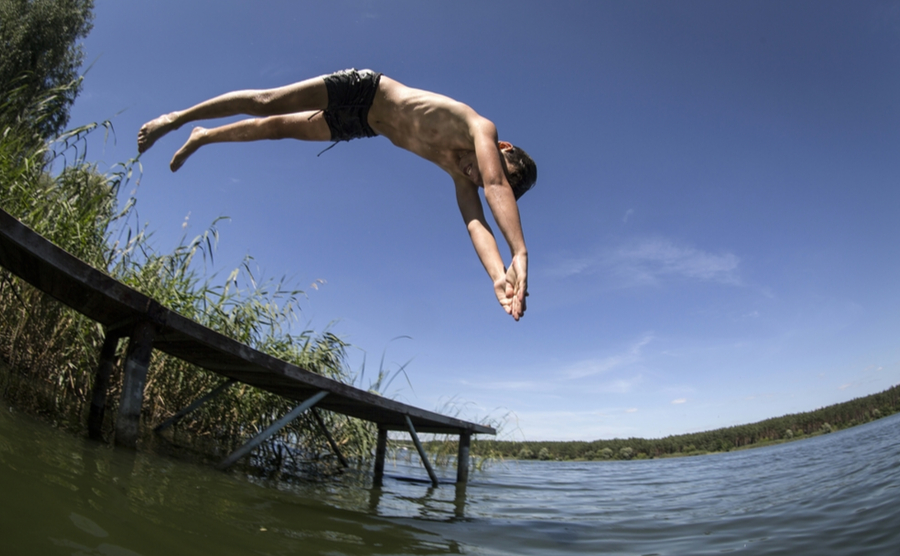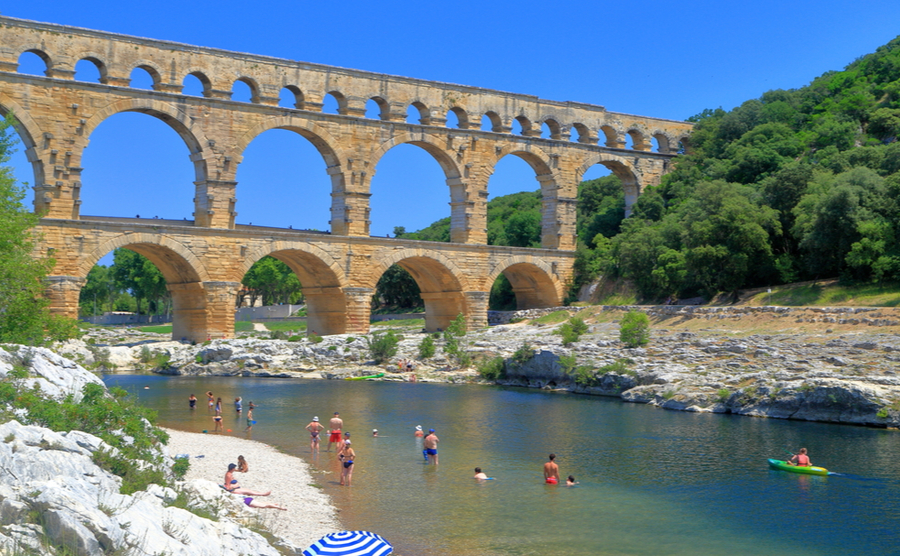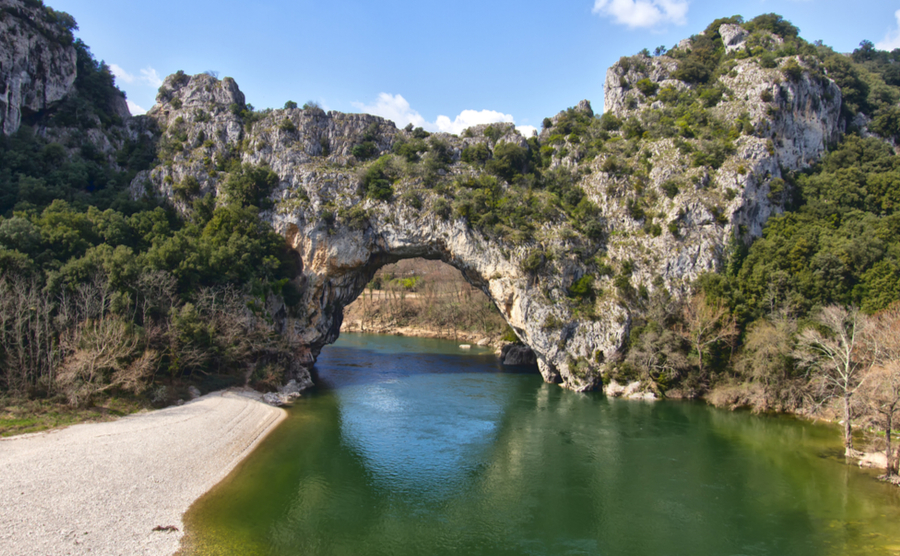Being large and squarish, in France you can find yourself a long way from a beach. No problem, when there are such beautiful rivers and lakes to swim in. Wild swimming, as swimming outdoors in rivers and lakes rather than in municipal pools is known, has dramatically risen in popularity. It even featured in the Paris Olympics, to varying success. Here we highlight the rise of wild swimming in France, with a few do’s and don’ts and recommendations on where to swim.
Wild swimming has recently seen a huge growth in popularity. It not only satisfies a human need for freedom and liberation, but is one of the best exercises for body and mind. Plus, it’s free!
France has longer, prettier and generally cleaner rivers than much of the UK, so many Brits are choosing to take their hobby with them when moving to France, encouraged by the French government that apparently values the cleanliness of its water much more. Paris’s mayor, Anne Hidalgo, made swimming in the Seine a key part of the Olympics.
That had mixed success fter heavy rain spilled into the Seine creating high levels of pollution. The events eventually took place with the water declared by one winning Brit as “tasting a bit muddy but generally okay”. So just how safe is wild swimming in France, and would you have to be insane to take a dip in the Seine?
Find homes in France via our property portal.
The benefits of wild swimming
Wild swimming is simply defined as “the pastime of swimming for enjoyment outside within natural pools of water”. That includes anything from oceans to rivers, lakes, natural pools and waterfalls, salt or fresh water. The point is that it’s not in a man-made structure.

Ready to take the plunge with wild swimming in France?
Afficionados do it for the challenge, for the sense of freedom and feeling alive, as a form of mediation and self-discovery, or just because it’s a free way to keep cool on a hot day.
Swimming has always been recognised as being good for cardio health, building up endurance and muscle strength, especially if retiring to France. It’s also renowned for alleviating stress and anxiety. Wild swimming has the added bonus of reconnecting you to nature, while cold water immersion is known to be great for boosting the immune system. Other benefits include boosting dopamine levels and increasing endorphins, improving circulation as well as reducing body pain and inflammation.
An added bonus, it can be completely free, during a cost of living crisis. It requires very little equipment (indeed, none at all if you’re brave enough!), although some like to use a wetsuit, for health reasons nose clips and goggles can be sensible, and a swimming buoy is a sensible precaution if you’re nervous, doubling as a place to store your valuables.
The rise of wild swimming
The pandemic without doubt accelerated the popularity of wild swimming, with pools and gyms closed, and as an antidote to the stresses that built up during that time. According to Outdoor Swimmer magazine, 45% of swimmers increased how much they swam outside in 2020, with outdoor swimming numbers possibly trebling from 2019.
Numbers appear to be similar in other countries. The Outdoor Swimming Society (OSS) has in the past few years seen its membership rise to more than 170,000 across 28 countries, while social media and websites encourage people to share the best wild swimming locations..
The risks of wild swimming
However, alongside cited benefits, there are some prudent precautions if you fancy wild swimming. These include keeping your mouth closed as much as possible whilst swimming in outdoor waters and covering any cuts or grazes with a plaster. A wet-suit will keep you warm and buoyant and a swim buoy is something to cling onto and if be more visible.
It is also sensible to go with a friend, and if not accompanied, tell someone where you’re going and when you’ll be back.
When jumping from height, of course you should ensure you conduct all due diligence as to what lies beneath. In lesser known locations be prepared to see slightly more of other swimmers than you may be prepared for!
The Royal Life Saving Society UK has a published list of useful wild swimming tips including awareness around jumping into unknown territory, visibility in open waters as well as dangers of currents.
Wild swimming in France
There could perhaps be no better place to take up the sport of wild swimming than in France. A country spoilt by nature in its number of resident gorges, waterfalls, lakes, rivers and reservoirs. Not to mention artificial lakes, used to store water and generate electricity. In some ways, to the natives wild swimming in France is by no means a new phenomenon.
A quarter of drinking water comes from rivers, therefore water quality in France is generally good. Take care though when swimming wild in close proximity to farms as agricultural waste is often dispersed into rivers in these areas. In the South of France, the water quality is very good, particularly within the National Parks.
Rules and regulations
There are few hard and fast rules for wild swimming in France. Mainly due to most waterways being public property. However, it is at the discretion of the local municipality, should they wish to impose them. Which is mainly only done in response to concerns over safety risks or concerns of water pollution.
Dangerous sites will be clearly marked. Ignore these at your peril. The main marker to determine whether rules are imposed or not, are the following signs:
Une baignade autorisée et surveillée = swimming allowed and supervised
Une baignade autorisée et non surveillée = swimming allowed and not supervised
Une baignade interdite = swimming prohibited.
The absence of signage is generally taken as carte blanche to go ahead. Of course, France is notorious for ignoring rules – anyone following a native towards a closed road sign may attest to – but remember that these rules are for your own safely.
Neither are there normally strict rules about appropriate clothing. So while in most pools it’s a case of speedos only, you can wear your swimming shorts when wild swimming. France is a nation that prides itself on not having to state the obvious, so remember that general laws on indecency apply, particularly in areas where you could be seen by others, including children.
France’s best wild swimming sites
When it comes to searching out the perfect spot for wild swimming in France, Google is your friend. A search of “Wild swimming France map” will show the locations of some of the best spots. Such as on this website.
Whilst difficult to say there are “official” wild swimming sites in France, you can just follow the crowds to the perfect spots, where there may well be facilities for both parking and changing. Places like Pont Du Gard, located close to Nimes under the magnificent Roman Aquaduct seem to have been created exactly for this. With parking facilities and shallow cool waters it’s the perfect place for the whole family to hang out together.

Pont du Gard, Nimes
At the Gorge du Verdon, known as France’s answer to the Grand Canyon, lies an un-spoilt perfect turquoise blue river, with the bonus of cliffs surrounding it providing plenty of shade. Used for canoeing, kayaking and simply “messing about on the river”, it’s the perfect choice.
The Dordogne is known for having long stretching rivers adorned by little stony coves interspersed along its length. Invoking for me many happy memories swimming as a child here during pit stops during an otherwise lengthy drive through France.

Tempted for a dip? Vallon Pont d’Arc, in the Ardeche
One of the most famous swimming spots in France is Lac d’Annecy, warmed by thermal springs and set against the breathtaking backdrop of the Alps.
The Ardeche is another region known for having renowned sites for this activity. Provided by nature in the form of Jurassic archways with the river flowing through them. With a particularly popular site here being Vallon Pont d’Arc, located one hour north-west of Orange.
However, why not find your own favourite spot?
You can discover much more about Wild Swimming in France with this book:










